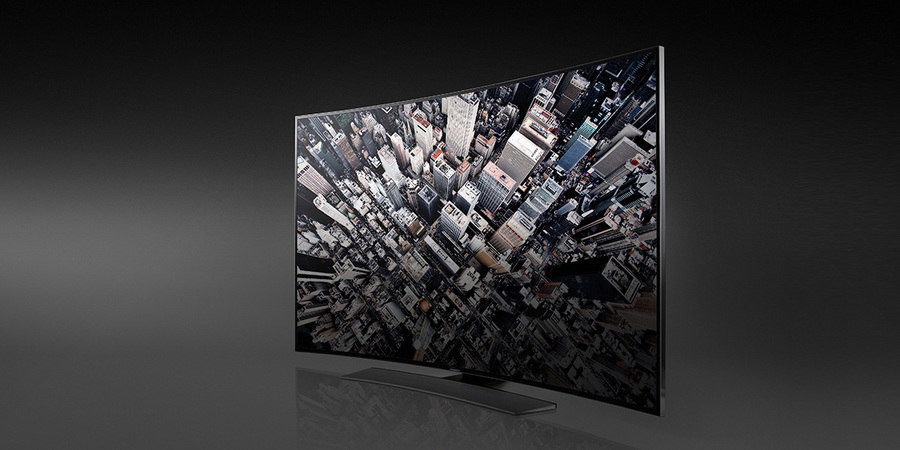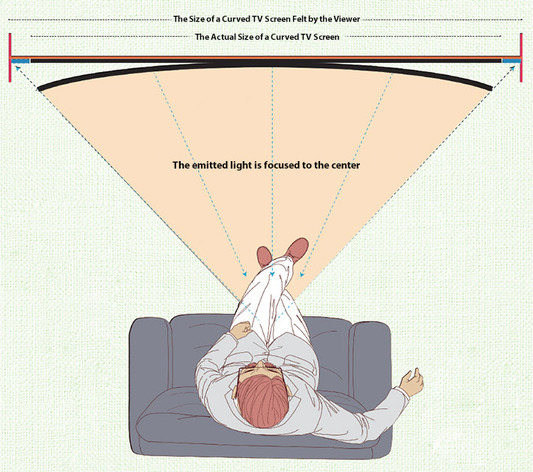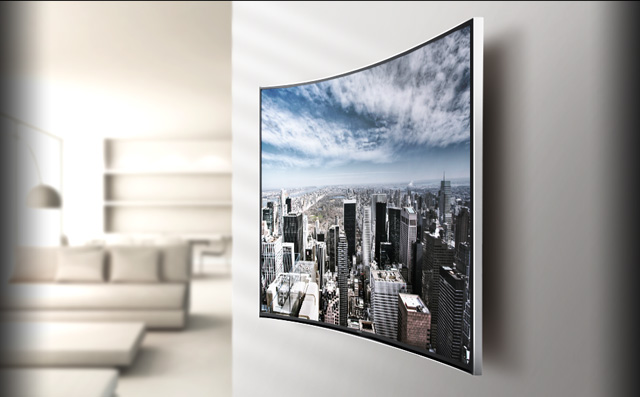 If there are a couple of major trends in TVs for 2016, they are definitely 4K or Ultra HD, and curved screens. We wrote about 4K TV and what makes it great not long ago on the blog, so now the focus is on why curved screens are growing in popularity.
If there are a couple of major trends in TVs for 2016, they are definitely 4K or Ultra HD, and curved screens. We wrote about 4K TV and what makes it great not long ago on the blog, so now the focus is on why curved screens are growing in popularity.
Why are curved screens popular?
There are a couple of reasons why curved screens are near the top of people’s wish lists for 2016. One of those is aesthetics, the other is science. Kinda. Allow me to explain.
It looks good
A lot of people just like the look of a curved TV. Much like the sexy lines on a sports car, they’re aesthetically pleasing. Some folks also love having the newest and hottest gear in their home, so for them, a curved TV is a showpiece. There’s nothing wrong with liking the looks of your electronics, and these days curved TVs are proving popular among those looking for something a little different.
There’s science behind the curves
Now to the science. The explanation has always been that the curve on the screen mimics the curvature of the eye, and that by keeping the same viewing distance or angle as your eye travels from edge to edge across the screen, you experience less strain and fatigue. There’s been some debate, mainly among tech journalists, about how perceptible and noticeable the effect is.
A doctor studied the effect of curved monitors on the eye, and he concluded in a Korean news article called “SNUH Ophthalmologist: Curved Monitors Improve Eye Health” the curve does reduce eye strain.
“Our eyes adjust the thickness of the crystalline lens to maintain focus when the distance to viewed objects changes. The curved monitor offers similar eye-to-object distance at all angles, ensuring the eyes do not have to work as hard to readjust the crystalline lens to focus. Consequently, eye fatigue is minimized. This effect is especially beneficial to elderly users whose lens adjustment function has degenerated.” Does that translate to TVs?
Curves make the picture look bigger
 Dr. James Edward Sison, a consultant at the St. Luke’s Medical Center, told an online publication curved TVs have other benefits; “the curved UHD TV screen gives a panoramic effect that makes the screen look bigger than it actually is. Even if people are watching together, the view of the periphery or edge of the TV is still clear, so those watching at the edges still experience the UHD effect.”
Dr. James Edward Sison, a consultant at the St. Luke’s Medical Center, told an online publication curved TVs have other benefits; “the curved UHD TV screen gives a panoramic effect that makes the screen look bigger than it actually is. Even if people are watching together, the view of the periphery or edge of the TV is still clear, so those watching at the edges still experience the UHD effect.”
So while there are scientific reasons for the curves, it appears to come down to how much you’re going to be able to appreciate both the aesthetics of the set itself and how much you’ll notice any lack of strain.
Reduced reflections?
If you’ve ever watched TV in a bright room on a sunny day you’ll know reflections can be annoying. Curved screens are supposed to help with the problem, but depending on what you read, they either do or don’t. Online tech magazine c/net found a reduced reflectiveness in its testing while another website found it just as bad. TrustedReviews wrote, “Anything bright in your room – especially direct light sources opposite your TV – has its reflection on a curved screen stretched and distorted across a wider area of the screen than would occur with a flat TV. So if you buy a curved TV, you’ll probably find you need to introduce some extra light control elements to your viewing room.”
Again, this may come down to location and personal preference; if you have it in a dark room you may never see a glare. If you’ve got it in a main upper floor living area that’s bright, it may be a problem for you.
Immersive video picture
One of the big reasons for choosing a curved TV is often the way it fills your field of vision with the video, particularly on very large TV sets. On this, it seems everyone can agree. Since the screen curves around you and creeps ever-so-subtly into your peripheral vision, you can really feel surrounded by all the action. That same curve for some folks can also supply an almost 3D-like effect, making the video look sharper (particularly at the edges) and feel like you’re seeing more depth and contrast.
Is there a downside to curved TVs?
When it comes to curved screens there aren’t downsides, so much as ‘cons’. For starters, curved TVs are more difficult to wall mount, and they can look a bit strange, as though they’re peeling off the wall. They also tend to be a bit thicker than regular flat 4K TVs, as there’s some additional hardware needed to make that sexy shape.
One of the other cons has been price, but expect curved TVs to come down in cost as time goes on. Other complaints about curved screens have been that you need to be in a sweet spot to get the best picture, but because of the wide viewing angle and the larger size of these TVs, that means more than just one person can be in the centre. So again, the jury may be out on this; if you have a family of six, someone will complain. If it’s just you and your spouse, you may both be able to be happy in the sweet spot.
What customers think
I wish I had some personal experience to share about curved screens. I’d love to hear any firsthand experience readers are willing to share so that we can all get a ‘real person’s’ understanding of whether curved screens are the way to go. Post your thoughts in comments below.
For now, take in some of the reviews on various curved TVs, like this LG 55″ 1080p 3D Curved OLED Smart TV; “ like being there, only better. Love it!”
Kash called his curved TV, “worth the purchase! A great TV…the picture quality is absolutely amazing! Coupled with the curved Samsung soundbar this is a no brainer purchase.”
If you’re thinking of going curved on your next TV, head over to a Best Buy store and do some recon. Check out the sets available like this Samsung 65″ 4K Ultra HD 3D Curved LED Tizen Smart OS TV (which gets 5 star ratings), and sit in front of one for a bit. See if you do notice the difference, or maybe you’ll just like the looks of the set. Trying TVs on for size is a great way to narrow your choices.
Want to learn more about new TV Tech? Check out the other articles in our series.
Diagram above courtesy AVSForums.com.



